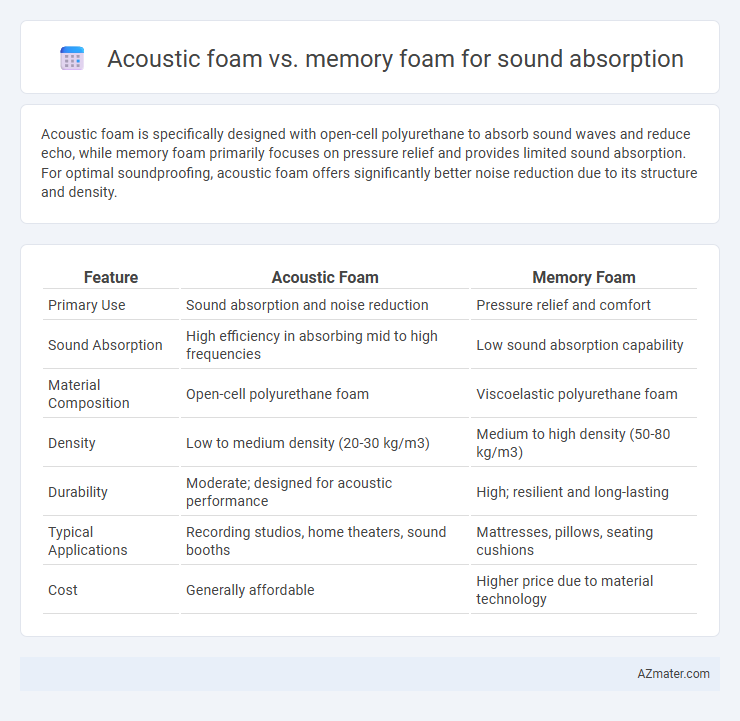Acoustic foam is specifically designed with open-cell polyurethane to absorb sound waves and reduce echo, while memory foam primarily focuses on pressure relief and provides limited sound absorption. For optimal soundproofing, acoustic foam offers significantly better noise reduction due to its structure and density.
Table of Comparison
| Feature | Acoustic Foam | Memory Foam |
|---|---|---|
| Primary Use | Sound absorption and noise reduction | Pressure relief and comfort |
| Sound Absorption | High efficiency in absorbing mid to high frequencies | Low sound absorption capability |
| Material Composition | Open-cell polyurethane foam | Viscoelastic polyurethane foam |
| Density | Low to medium density (20-30 kg/m3) | Medium to high density (50-80 kg/m3) |
| Durability | Moderate; designed for acoustic performance | High; resilient and long-lasting |
| Typical Applications | Recording studios, home theaters, sound booths | Mattresses, pillows, seating cushions |
| Cost | Generally affordable | Higher price due to material technology |
Introduction to Acoustic Foam vs Memory Foam
Acoustic foam is specifically designed to absorb sound waves, reduce echoes, and improve room acoustics through its open-cell structure and wedge shapes, making it ideal for recording studios and soundproofing applications. Memory foam, while primarily engineered for comfort and support in mattresses and cushions, exhibits limited sound absorption due to its dense and closed-cell composition. Understanding these material properties highlights why acoustic foam outperforms memory foam in sound absorption and noise control scenarios.
Understanding Sound Absorption Principles
Acoustic foam is designed with open-cell structures that trap sound waves, converting them into heat and effectively reducing reverberation and echo in a space. Memory foam, while dense and capable of dampening vibrations, lacks the porous texture necessary to absorb sound waves efficiently, making it less effective for sound absorption purposes. Understanding sound absorption principles highlights that materials with high porosity and airflow resistance, like acoustic foam, are optimal for minimizing sound reflections and improving acoustic clarity.
What is Acoustic Foam?
Acoustic foam is a specialized material designed to reduce echo and absorb sound waves, enhancing audio clarity in recording studios, theaters, and offices. Its open-cell structure traps and dissipates sound energy, minimizing reverberations and noise pollution. Unlike memory foam, which primarily focuses on comfort and pressure relief, acoustic foam's primary function is sound absorption and acoustic treatment.
What is Memory Foam?
Memory foam, a viscoelastic polyurethane material, is engineered to conform to body shapes by reacting to pressure and temperature, commonly used in mattresses and cushions for comfort rather than soundproofing. Acoustic foam, specifically designed for sound absorption, features open-cell structures that trap and dissipate sound waves, reducing echo and reverberation in a space. While memory foam can provide minimal sound dampening due to its density, it lacks the porous architecture critical for effective acoustic treatment compared to specialized acoustic foam panels.
Acoustic Foam: Key Features and Benefits
Acoustic foam is specifically designed to absorb sound waves, reducing echo and reverberation in rooms for improved audio clarity. Its open-cell structure and varying thicknesses optimize sound absorption across a wide frequency range, making it ideal for studios, theaters, and recording environments. Unlike memory foam, which primarily provides comfort and pressure relief, acoustic foam enhances soundproofing by trapping and dissipating noise energy.
Memory Foam: Key Features and Benefits
Memory foam offers superior sound absorption due to its dense, open-cell structure that effectively traps and dampens sound waves, reducing echo and noise transmission. Unlike acoustic foam, memory foam's viscoelastic properties allow it to conform closely to surfaces, enhancing its ability to isolate and absorb a broad range of frequencies. This makes memory foam an ideal choice for improving acoustics in recording studios, home theaters, and noise-sensitive environments.
Sound Absorption Performance: Acoustic vs Memory Foam
Acoustic foam is specifically engineered with open-cell structures to maximize sound absorption by reducing echo and reverberation, making it highly effective for controlling mid to high-frequency sound waves. Memory foam, designed primarily for comfort and pressure relief, has denser and less porous material properties, resulting in significantly lower sound absorption capabilities. For targeted soundproofing and acoustic treatment, acoustic foam remains the superior choice due to its optimized design for minimizing sound reflection and improving room acoustics.
Practical Applications: Where Each Foam Excels
Acoustic foam excels in sound absorption for practical applications such as recording studios, home theaters, and office spaces by effectively reducing echo and reverberation through its porous structure. Memory foam, while primarily designed for comfort, is less effective for acoustic treatment but can aid in sound insulation within mattresses and cushions due to its dense composition. For sound absorption needs focused on clarity and noise control, acoustic foam remains the preferred choice, whereas memory foam serves better in noise dampening through physical cushioning.
Cost and Accessibility Comparison
Acoustic foam is generally more affordable and widely accessible, making it a popular choice for sound absorption in studios and home theaters. In contrast, memory foam tends to be costlier due to its specialized material properties and is less commonly used for acoustic treatment, limiting its availability. Budget-conscious buyers aiming for effective sound absorption typically prefer acoustic foam due to its cost-efficiency and ease of purchase.
Choosing the Right Foam for Your Sound Absorption Needs
Acoustic foam is specifically designed to absorb sound waves, reducing echo and reverberation in spaces such as recording studios and home theaters, making it ideal for optimizing audio clarity. Memory foam, while dense and effective for comfort in mattresses and cushions, lacks the porous structure necessary for significant sound absorption, resulting in minimal acoustic benefits. Choosing the right foam depends on your sound absorption goals: prioritize acoustic foam for controlling noise and enhancing sound quality, while memory foam is better suited for comfort rather than effective soundproofing.

Infographic: Acoustic foam vs Memory foam for Sound absorption
 azmater.com
azmater.com